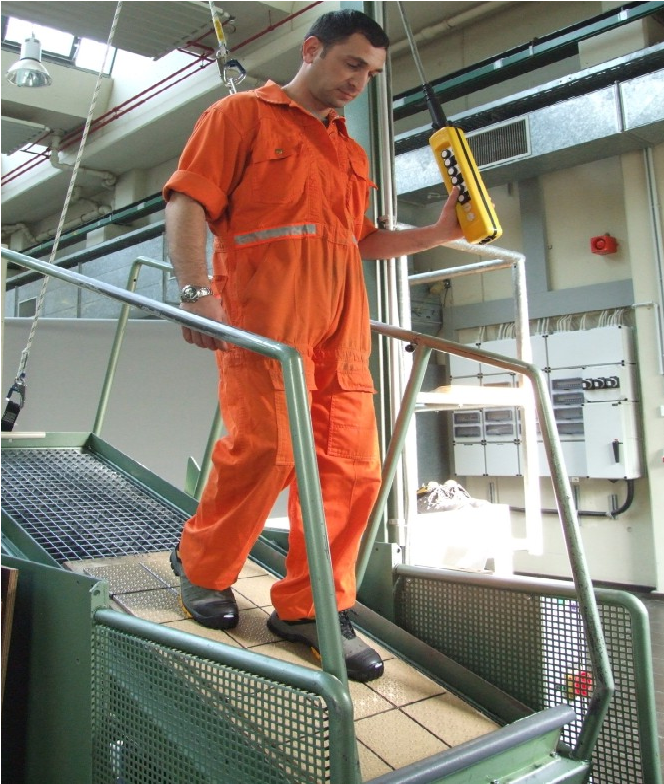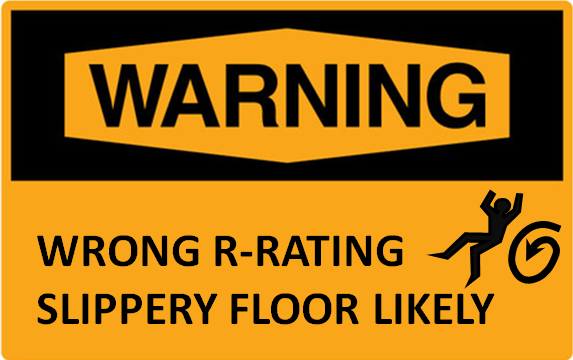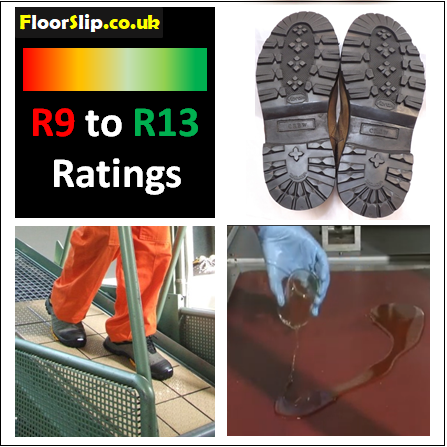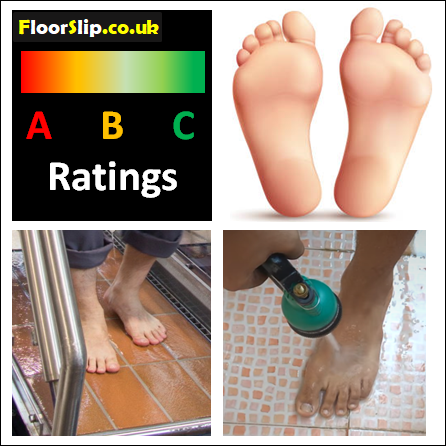Floor Slip Resistance Ramp Testing
The Floor Surface Ramp Test is used Worldwide to determine the Floor Slip Resistance of a SPECIFIC Floor Surfaces, Contaminants and Footwear / Bare Feet in conjunction with each other to arrive at an R-Rating (shod) or ABC Rating (bare feet). The Ramp Test is NOT designed for specifying general floor surfaces, which require a Minimum Floor Pendulum Test Value. (See Buying New Floors), even where a Ramp Test has been conducted.
The Floor Slip Resistance Ramp Test

The Ramp Test is relatively simple test (though quite expensive as compared to Floor Pendulum Testing) performed on a surface where a ramp with the flooring attached is raised up one degree at a time until a person slips, when that person slips then the angle is measured and a determination of slip resistance is arrived at. Ramp Testing is good for comparative testing of floor surfaces where a determination of which surfaces of different types provides the better Floor Slip Resistance.
The Floor Ramp Test raises the floor until an operator slips
Note that in many Floor Testing Standards where the Ramp Test is used, the Floor Pendulum Test is also a mandatory requirement to meet the standards.
For industrial type flooring requirements
The test operator will wear standard cleated soled boots, the Contaminant used is ‘usually’ motor oil (but may be changed to a contaminant relevant to a particular environment) and the test value arrived at is known as the R-Rating – Read more about R-Ratings.
The Shod Ramp Test determines Floor R-Ratings (R9,R10,R11,R12,R13)
For bare foot type flooring environments
The test operator is bare foot and the contaminant used is soapy water is a particular dilution and the value arrived at is known as the ABC-Rating – Read more about ABC-Ratings
The Bare Feet Ramp Test determines Floor ABC-Ratings
Standards Used in Floor Ramp Tests
(See our page on Floor Testing Standards for further details)
- EN-16165 – Annex A (Bare foot Test) and Annex B (Shod Foot Test), which are deemed to supersede the following (German) DIN Standards from 2022/2023....
- DIN-51097 – Barefoot Ramp Test
- DIN-51130 – Shod Foot Ramp Test
- EN-13845 – Determines the ESB and ESF values
Limitations of the Ramp Test

Warning – There is alot of INCORRECT information around about R-Ratings readacross to Pendulum Test Values (PTV). This misleading data has lead to many Floor Slip Injury Claims, which FloorSlip know well about because we specialise in preparing Expert Witness Reports in Floor Testing. The misunderstanding has misled architects and floor specifiers when Buying New Floors in selecting Floor R-Ratings to specify floors but R-Rating should NOT be used for the purpose of specifying general floors; only where an R12 or R13 is found can this assumption be considered. Below this at R9, R10 and R11 (there is nothing below R9) there is the high likelihood a floor will fail the On-Site Floor Pendulum Test, which means the floor will not meet the HSE Requirements for Safe Floors. If you are a specifier, builder or Architect etc. in this situation, send FloorSlip a sample and we will conduct a very affordable Floor Sample Pendulum Test upon it BEFORE you spend many thousands on purchasing floors!
Floor Ramp Test Limitations
- The Floor Ramp Test equipment is expensive and bulky and an established workshop is generally required; as opposed to Mobile Pendulum Testing at Affordable Prices
- Mobile ramp test equipment is available but the tests require 2 operators and the logistics of transporting the equipment and setting it up are expensive and require a location to test in.
- Many of the Floor Testing Standards also expect the Pendulum Test to be conducted as well because on its own, the Ramp Test will not necessarily meet HSE recommendations for Safe Floors
- The Ramp Test does not determine the Dynamic Heel-Sssssslip!!! which occurs in normal pedestrian traffic, this is a task that is represented by the On-Site Floor Pendulum Test and can be performed in Floor Sample Testing
- The bare foot test has no limitations upon the test surface as it is just skin but the test using cleated boots will change results when boots of different rubber hardness and sole / heel pattern changes.
- The Ramp Test is only conducted on a limited floor area (approx. 1 meter square) and typically on new flooring so is not representative of a true installation where different Floor Wear occurs; this is where the On-Site Pendulum Floor Slip Test has its advantages.
- The Ramp Test is also subject to how the operator walks (gait), the operator’s weight and foot size; all parameters, which are variable so a variable set of results will occur. Whereas the Floor Slip Pendulum Test will provide repeatable accurate readings over and over again and can be used to detect and Monitor Floor Wear.
- The Ramp Test is often accompanied by a Pendulum Test but the test results end up with a Range of Pendulum Test Values, which can be misleading for floor specifiers.
.png)
.png)
.png)

